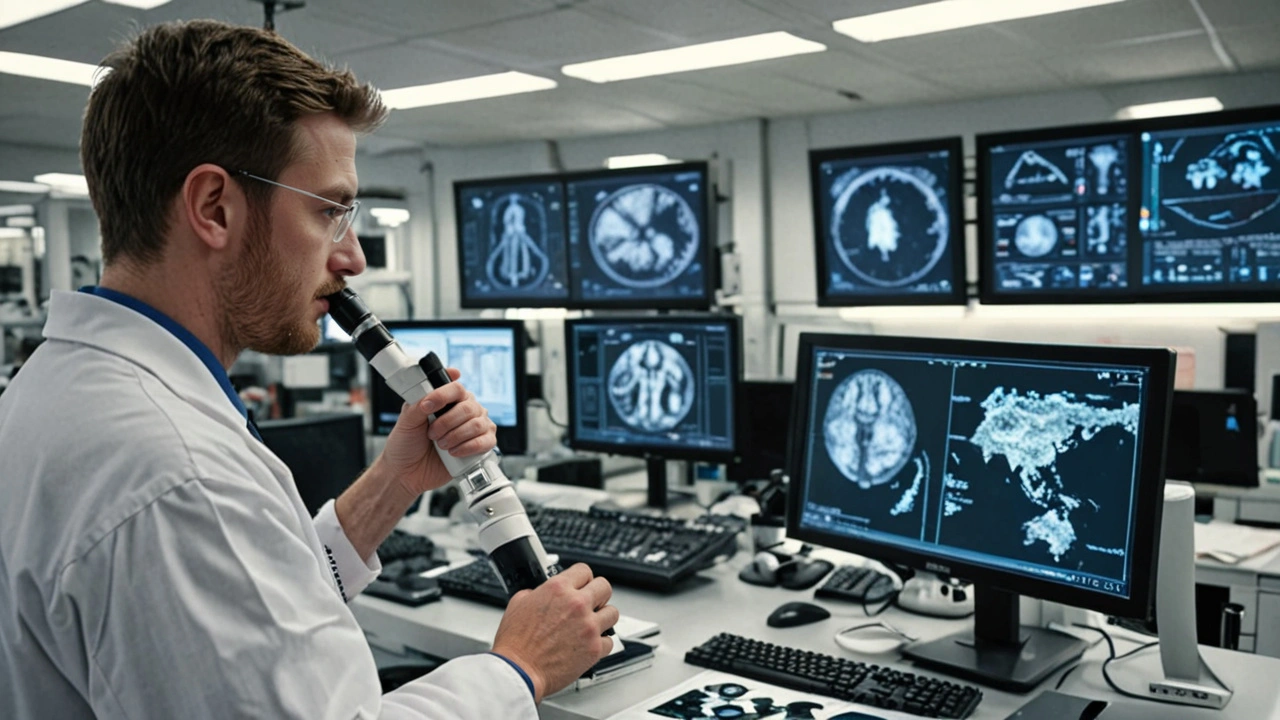Amebiasis, a parasitic infection caused by the Entamoeba histolytica parasite, affects millions of people globally. The condition often spreads through contaminated food and water, posing a significant health risk in areas with poor sanitation. Diarrhea, abdominal pain, and severe complications can result from untreated infections, leading to a pressing need for effective medical interventions.
Over the years, various treatment strategies have been developed to combat amebiasis. Traditional methods typically involve administering antibiotic medications, such as metronidazole or tinidazole, to eliminate the parasite from the infected person's body. These treatments often prove effective but are not without limitations, especially in regions where healthcare access is limited.
Innovative medical technologies are paving the way for more efficient and accessible treatments. Advances such as rapid diagnostic tests, new drug formulations, and improved sanitation measures are showing potential in reducing infection rates. Researchers are also exploring vaccine development to provide long-term immunity against amebiasis, which would significantly alter the landscape of this public health issue.
Looking ahead, the combination of these medical advances could drastically reduce the prevalence of amebiasis globally. Enhanced diagnostic tools, coupled with novel treatments and preventive measures, promise a future where infection rates are significantly lowered. These developments will not only improve individual health outcomes but also contribute to broader public health achievements worldwide.
- Understanding Amebiasis
- Current Treatment Strategies
- Innovative Medical Technologies
- Future Impact on Infection Rates
Understanding Amebiasis
Amebiasis is a parasitic infection caused by the Entamoeba histolytica parasite. This single-celled organism thrives in unsanitary conditions, often spreading through contaminated food and water. It's particularly common in tropical regions where clean water and proper sewage systems are lacking. Amebiasis can affect anyone, but it poses a higher risk to people with compromised immune systems, young children, and the elderly.
The infection process begins when a person ingests cysts, the dormant form of the parasite, via contaminated sources. These cysts travel to the small intestine, where they transform into their active, tissue-destroying form known as trophozoites. The trophozoites invade the intestinal lining, causing symptoms such as diarrhea, abdominal pain, and fever. In severe cases, the parasite can penetrate deeper tissues, leading to liver abscesses and other life-threatening complications.
Early detection and diagnosis are crucial for effective treatment of amebiasis. Typically, diagnosis involves stool sample tests, where microscopic examination can reveal the presence of E. histolytica cysts or trophozoites. Recent advancements have introduced more sophisticated methods, such as polymerase chain reaction (PCR) tests, which can identify the parasite's DNA with higher accuracy. These innovations are essential in distinguishing E. histolytica from other non-pathogenic species, ensuring proper treatment.
A key aspect of managing amebiasis involves understanding its transmission. Personal hygiene, such as regular hand washing and proper food handling practices, plays a significant role in preventing contamination. Public health initiatives focused on improving sanitation infrastructure are equally vital. In regions where amebiasis is endemic, educational programs that inform communities about these practices can drastically reduce infection rates.
The human impact of amebiasis extends beyond immediate health concerns. Chronic infections can lead to malnutrition and weakened immunity, making individuals more susceptible to other illnesses. Moreover, the economic burden of treating amebiasis and its complications drains resources in already struggling healthcare systems. Addressing these challenges requires a multifaceted approach, combining medical, social, and infrastructural efforts.
Interestingly, historical data shows that amebiasis has been a persistent problem for centuries. Ancient writings from societies like the Greeks and Egyptians describe symptoms consistent with the disease. However, it wasn't until the 19th century that scientists identified the exact cause. In 1875, a Russian physician named Fedor A. Lösch first discovered E. histolytica while investigating a dysentery outbreak. His work laid the foundation for our modern understanding of this pathogen.
To provide some perspective, consider the World Health Organization's estimate that around 50 million people worldwide suffer from amebiasis each year, resulting in up to 100,000 deaths annually. These statistics underscore the urgent need for effective interventions.
"Public health efforts must focus on both treatment and prevention to combat amebiasis effectively," says Dr. Maria Martinez, an infectious disease expert. "Investing in clean water and sanitation infrastructure can make a huge difference in reducing the spread of this parasite."
Recent studies highlight the potential for new treatment options. Researchers are exploring drugs that specifically target the unique biology of E. histolytica, minimizing side effects and improving patient outcomes. These advancements could revolutionize how we approach amebiasis and reduce its global impact significantly.
As we delve deeper into the complexities of amebiasis, it becomes clear that a combination of scientific innovation, public health strategies, and global cooperation is essential to overcoming this age-old challenge. By staying informed and proactive, we can contribute to a future where amebiasis is effectively controlled and ultimately eradicated.

Current Treatment Strategies
Treating amebiasis typically involves a multi-step approach aimed at both eliminating the parasite and alleviating symptoms. One of the most commonly prescribed medications is metronidazole, which is often used as the first line of defense. This antibiotic works by targeting the DNA of the parasite, thereby killing it. Patients usually take metronidazole for a course of seven to ten days, depending on the severity of the infection. Although effective, some people may experience side effects such as nausea and a metallic taste in their mouth.
Another widely used drug is tinidazole. Similar to metronidazole in its mechanism of action, tinidazole tends to have a slightly longer half-life, allowing for shorter treatment durations. Patients typically take tinidazole for three to five days. The drug is particularly effective against both the active trophozoite form of the parasite and the cyst form, which is more resistant to treatment. Side effects are similar to those of metronidazole but are generally less intense.
In cases where the infection is confined to the intestines, doctors may prescribe paromomycin. This antibiotic specifically targets the parasitic cysts, which are often the cause of recurrent infections. Paromomycin is usually administered over a course of ten days and is well-tolerated by most patients. For liver abscesses caused by amebiasis, medications like chloroquine may be used in conjunction with metronidazole or tinidazole to fully eradicate the infection.
Challenges in Treating Amebiasis
One of the main challenges in treating amebiasis lies in diagnosing the condition accurately and promptly. Rapid diagnostic tests are becoming more popular, but in many parts of the world, healthcare providers still rely on microscopy and culture techniques, which can be time-consuming and less reliable. Moreover, the misuse of antibiotics has led to the emergence of drug-resistant strains of the parasite, complicating treatment efforts.
Accessibility to these treatments is another significant issue. In developing countries, where amebiasis is most prevalent, healthcare infrastructure may not be robust enough to ensure that all patients receive the necessary medications. Poor sanitation and lack of clean drinking water further exacerbate the situation, leading to higher infection rates and recurrent cases. These challenges necessitate a comprehensive approach that combines medical treatment with public health interventions.
According to Dr. Jane Atkinson from the World Health Organization, "Efforts to combat amebiasis must address both medical treatment and preventive measures. This multifaceted approach is crucial for reducing infection rates worldwide."

Innovative Medical Technologies
Innovative medical technologies are transforming how we approach the treatment and prevention of amebiasis, bringing new hope in combating this parasitic infection. One remarkable advancement is the development of rapid diagnostic tests. These tests allow healthcare providers to quickly identify the presence of Entamoeba histolytica, enabling prompt treatment. Unlike traditional lab tests, which can take days, rapid diagnostics deliver results in minutes. This speed is crucial in areas where healthcare resources are limited, allowing for timely intervention and reducing the risk of spreading the infection.
Another groundbreaking area is the creation of new drug formulations. Traditional drugs like metronidazole have long been used to treat amebiasis, but they come with side effects and resistance issues. Researchers are now focusing on developing drugs that are more effective and have fewer side effects. One study has shown that nitazoxanide, originally used for other parasitic infections, shows promise in treating amebiasis with a better safety profile.
Improved sanitation measures are also playing a significant role in reducing infection rates. Innovations in water purification and sanitation facilities can greatly decrease the transmission of the parasite. Simple yet effective solutions, such as inexpensive water filters and community sanitation programs, have already shown a drastic reduction in infection rates in various regions. These measures not only protect individuals but also contribute to community-wide health improvements.
"Access to clean water and proper sanitation is one of the most effective ways to prevent the spread of amebiasis," says Dr. Ellen Ferguson, an infectious disease specialist. "With current innovations, we have the technology to make this a reality in many parts of the world."
Researchers are also making strides in developing a vaccine for amebiasis. Although still in the experimental stages, a vaccine would offer long-term protection against the infection, which could be a game-changer in regions where amebiasis is endemic. Experimental trials have shown promising results, with preliminary data indicating a high level of immunity in vaccinated subjects. If these vaccines prove effective in larger clinical trials, they could potentially eradicate the parasite in the future.
Furthermore, technology is enhancing educational outreach. Mobile health applications and telemedicine are increasingly being used to educate communities about safe practices and symptoms of amebiasis. These tools are particularly useful in remote areas where traditional healthcare infrastructure is lacking. By providing crucial information and support, these digital platforms empower individuals to take preventive measures and seek timely medical attention.

Future Impact on Infection Rates
The future of combating amebiasis looks promising as advances in medical science continue to evolve and make significant headway. These developments could bring substantial changes in how we approach the prevention, diagnosis, and treatment of this parasitic infection. One of the key factors in reducing infection rates will be the widespread implementation of rapid diagnostic tools. Quick and accurate detection can ensure timely treatment, reducing the transmission risk. By catching the infection early, healthcare providers can administer the necessary interventions before complications arise.
Another promising area is the ongoing research into new drug formulations. Scientists are working on medications that can target the parasite more effectively while minimizing side effects. These next-generation treatments aim to be more accessible, easier to administer, and tailored to diverse healthcare settings, especially in low-resource areas. Moreover, these advancements promise to reduce the occurrence of drug resistance, a significant challenge with current treatment regimes.
Preventative measures, particularly vaccines, hold great potential in reducing amebiasis rates in the future. Researchers are exploring vaccine candidates that could offer long-term immunity against the Entamoeba histolytica parasite. If successful, vaccination strategies could prevent cases of amebiasis altogether, particularly in endemic regions. This proactive approach could lead to a substantial decline in global infection rates, improving overall public health.
Improved sanitation and hygiene practices are also crucial. Modern sanitation technologies, clean water initiatives, and public health campaigns can mitigate the environmental factors that facilitate the spread of the parasite. Simple interventions like encouraging handwashing and safe food practices can have a significant impact. Integrating these efforts into community health programs can foster sustainable, long-term changes and promote healthier living conditions.
Another important factor is the role of education and public awareness. Educating communities about amebiasis transmission and prevention can empower individuals to take charge of their health. Schools, local health agencies, and community organizations can work together to disseminate information and create awareness, leading to a more informed and vigilant population.
Additionally, collaborations between governments, international health organizations, and the private sector will be vital in ensuring that innovations in amebiasis treatment and prevention are accessible globally. These partnerships can support the distribution of new diagnostics, treatments, and vaccines, especially in regions most affected by the infection. By working together, these stakeholders can create a united front against amebiasis, significantly reducing its impact.
A case study from India shows the effectiveness of integrated health programs in reducing infectious diseases. In regions where public health campaigns were combined with improved sanitation and the availability of rapid diagnostic tests, there was a notable decrease in amebiasis cases. This real-world example illustrates how comprehensive strategies can make a tangible difference and pave the way for future success.
In summary, the future impact on amebiasis infection rates will depend on multi-faceted approaches that include scientific advancements, preventative measures, public education, and global partnerships. By leveraging these tools and strategies, we can anticipate a significant decrease in amebiasis cases, leading to better health outcomes and enhanced quality of life for many.





JAY OKE
July 11, 2024 AT 04:01Man, I remember getting sick in India back in '19. Thought it was just food poisoning. Turned out to be amebiasis. Took me weeks to shake it. No joke, clean water isn't a luxury-it's survival.
Brittany Medley
July 11, 2024 AT 20:24It's fascinating how much progress we've made in diagnostics-PCR tests are game-changers. But let’s not forget: no amount of fancy tech fixes a broken sewage system. Prevention > treatment, always.
Kaushik Das
July 13, 2024 AT 17:26In my village in Bihar, they started using ceramic filters last year-cost less than a cup of coffee per household. Infection rates dropped by 60% in six months. Simple, cheap, effective. Why don’t we hear more about this?!
Amanda Wong
July 13, 2024 AT 21:43Let’s be honest-this whole article reads like a WHO press release. You think a vaccine is going to magically appear while people still drink from puddles? Wake up. The real problem isn’t medicine-it’s corruption, apathy, and global neglect.
Micaela Yarman
July 14, 2024 AT 08:17As someone who has worked in rural clinics across Central America, I can confirm: the most impactful intervention isn’t a drug or a diagnostic-it’s teaching children to wash their hands before eating. Basic. Undervalued. Life-saving.
mohit passi
July 15, 2024 AT 11:36Life is a cycle, man. Parasites, humans, water, dirt-it's all connected. We think we're so advanced, but we're still just animals trying not to get sick from our own waste. Maybe the real solution is humility, not a vaccine 🤔
Cynthia Springer
July 17, 2024 AT 08:31Has anyone looked into whether climate change is increasing cyst survival rates in water sources? Warmer temperatures could be extending the parasite’s window of transmission. That’s not being discussed enough.
Ali Miller
July 18, 2024 AT 19:06Why are we wasting money on vaccines for a 'third-world problem'? We should be fixing our own hospitals, not giving handouts to countries that can't even manage their own trash. Taxpayer money isn't a global charity fund.
Joe bailey
July 19, 2024 AT 01:04Joe from London here-just read this while waiting for my bus. Seriously though, if we can send rovers to Mars, why can't we pipe clean water to every village? It’s not rocket science. It’s just willpower.
Asia Roveda
July 19, 2024 AT 09:44Of course the article ignores the fact that Big Pharma doesn’t want a cheap, lasting solution. Vaccines? Sanitation? No profit. They make billions off metronidazole prescriptions. This whole thing is a scam.
Aaron Whong
July 19, 2024 AT 16:27One might posit that the ontological framework of parasitism mirrors the epistemological collapse of public health infrastructure-where neoliberal fragmentation renders biological systems as commodified vectors of capital accumulation. The cure isn’t pharmacological-it’s structural.
Sanjay Menon
July 19, 2024 AT 18:27I mean, it’s cute that you all think this is a solvable problem. But let’s be real-humanity is a failed experiment. We pollute, we ignore, we hoard. Amebiasis isn’t a disease-it’s nature’s polite reminder that we don’t deserve to survive.
Marissa Coratti
July 20, 2024 AT 06:33While the scientific advancements detailed in this piece are indeed commendable, one must also consider the sociopolitical determinants of health equity. The disparity in access to diagnostic tools between urban centers in the Global North and rural communities in the Global South reflects not a technological deficit, but a moral one. We must not conflate innovation with justice.
Rachel Whip
July 20, 2024 AT 17:35Just wanted to add-paromomycin is underused. It’s safe for kids and pregnant women. If you're treating intestinal amebiasis without it, you're doing it wrong. Talk to your doctor.
Ezequiel adrian
July 22, 2024 AT 16:40Bro, in Lagos we use boiled water and lemon. Works better than most pills. 🍋💪
Stephen Adeyanju
July 23, 2024 AT 10:25Metronidazole gives me the worst hangover ever. Just saying. Also tinidazole tastes like metal socks. Why do we still use this stuff?
james thomas
July 24, 2024 AT 00:44They’re hiding the truth. Amebiasis isn’t natural-it’s a bioweapon designed to thin out the population. The WHO is in on it. You think clean water is expensive? Try finding a doctor who’ll admit the real agenda.
Deborah Williams
July 24, 2024 AT 15:37Oh, so now we’re pretending poverty is a solvable technical problem? How quaint. The real innovation would be redistributing wealth so people can afford to live without drinking sewage. But hey, let’s keep funding vaccines instead of universal healthcare. That’ll fix everything.
Sufiyan Ansari
July 24, 2024 AT 21:01In ancient India, we used neem leaves and boiled water for purification. Modern science has validated many of these practices. The fusion of traditional knowledge with contemporary diagnostics may offer the most sustainable path forward.